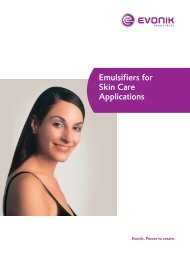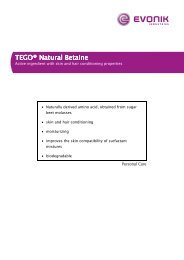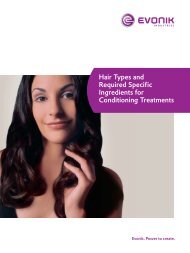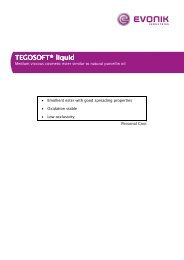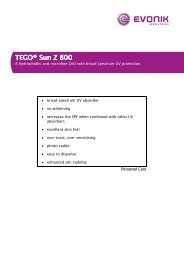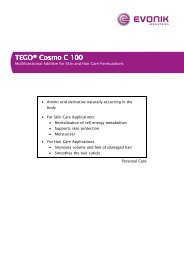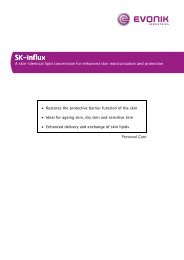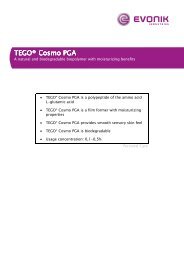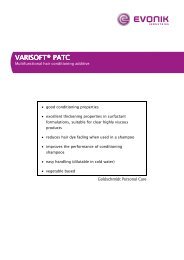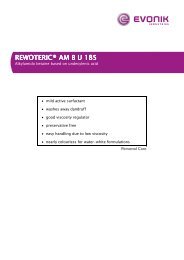ISOLAN® GPS ISOLAN® GPS
ISOLAN® GPS ISOLAN® GPS
ISOLAN® GPS ISOLAN® GPS
Create successful ePaper yourself
Turn your PDF publications into a flip-book with our unique Google optimized e-Paper software.
ISOLAN® <strong>GPS</strong><br />
Emulsifier for low viscous W/O lotions<br />
• PEG-free emulsifier based on vegetable<br />
raw materials<br />
• Excellent emulsion stabilization properties even at<br />
low emulsifier concentrations (2 - 3 %)<br />
• For the formulation of low viscous W/O lotions with<br />
a very light skin feel<br />
• Allows the formulation of W/O lotions with a very<br />
low content of oil phase (down to 18 - 20%)<br />
• Provides a pleasant, non-oily skin feel<br />
Personal Care
INCI Name (CTFA Name)<br />
Polyglyceryl-4 Diisostearate/<br />
Polyhydroxystearate/Sebacate<br />
Structure:<br />
Properties:<br />
ISOLAN ® <strong>GPS</strong> is a clear to slightly turbid liquid. It has<br />
an HLB value of approx. 5.<br />
Application Characteristics<br />
ISOLAN ® <strong>GPS</strong> is a PEG-free W/O emulsifier based on<br />
natural raw materials.<br />
Because of its polymeric and polyfunctional structure<br />
ISOLAN ® <strong>GPS</strong> results in excellent stabilization of W/O<br />
emulsions. The inclusion of polyhydroxystearic acid<br />
moieties in the polymeric structure leads to<br />
minimized interaction of emulsion droplets resulting<br />
in low viscous W/O emulsions.<br />
• ISOLAN ® <strong>GPS</strong> is suitable for the formulation of<br />
cosmetic W/O creams and lotions. It is especially<br />
designed for the formulation of low viscous W/O<br />
lotions.<br />
• As typical usage concentration 2 - 3% ISOLAN ®<br />
<strong>GPS</strong> are recommended. In general no coemulsifiers<br />
are needed to obtain stable<br />
emulsions.<br />
• In combination with other emulsifiers, e.g. ABIL ®<br />
EM 90 (Cetyl PEG/PPG-10/1 Dimethicone) or<br />
ISOLAN ® PDI (Diisostearoyl Polyglyceryl-3 Dimer<br />
Dilinoleate), ISOLAN ® <strong>GPS</strong> can be used to obtain<br />
W/O emulsions with a lower viscosity.<br />
• ISOLAN ® <strong>GPS</strong> is particularly suitable for the<br />
formulation of low viscous W/O lotions including<br />
light emollients such as TEGOSOFT ® DEC<br />
(Diethylhexyl Carbonate) in order to obtain W/O<br />
lotions with a pleasant very light, non-oily skin<br />
feel. ISOLAN ® <strong>GPS</strong> can also be used for the<br />
formulation of light W/O emulsions having high<br />
contents of silicone oils (e.g. cyclopentasiloxane).<br />
• Consistency-enhancing or emulsion-stabilizing<br />
waxes can be used in combination with ISOLAN ®<br />
<strong>GPS</strong>. Recommended are hydrogenated castor oil<br />
in combination with high-melting hydrocarbon<br />
waxes or beeswax.<br />
• Depending on the composition of the oil phase,<br />
formulation of lotions is possible with very low oil<br />
phase content (down to 18 - 20%).<br />
• In general lotions can be formulated at oil phase<br />
contents of 18 - 30%.<br />
• Substances which can be processed include not<br />
only mineral oils, which in emulsions provide<br />
relatively few problems, but also fatty acid esters<br />
of short- and long-chained alcohols and<br />
vegetable triglycerides which are often difficult to<br />
emulsify. When working exclusively with<br />
triglycerides, freeze stability of emulsions could<br />
be improved by using ISOLAN ® PDI as coemulsifier.<br />
• Electrolytes are required in amounts of 1.0 -<br />
1.5 %. Amongst others, magnesium sulfate<br />
heptahydrate is best suitable for.<br />
• It is possible to process W/O Lotions based on<br />
ISOLAN ® <strong>GPS</strong> cold/cold. In cold processed<br />
formulations a viscosity enhancing and stabilizing<br />
system in the oil phase is necessary. 0.5 % Zinc<br />
Stearate proved to be most effective.<br />
• ISOLAN ® <strong>GPS</strong> is suitable for the formulation of<br />
W/O creams. The optimum range for the content<br />
of the oil phase is between 16 and 18 %.<br />
Depending on the composition ISOLAN ® PDI can<br />
be used as co-emulsifier.<br />
• ISOLAN ® <strong>GPS</strong> is suitable for the formulation of Sun<br />
Care products.<br />
• ISOLAN ® <strong>GPS</strong> can also be used to formulate Color<br />
Cosmetic products such as liquid foundations.<br />
Influence on the viscosity of the emulsion<br />
The viscosity of W/O emulsions based on ISOLAN ®<br />
<strong>GPS</strong> can be adjusted by three variables.<br />
1. Viscosity of the oil phase<br />
The viscosity of the external phase correlates directly<br />
with the viscosity of the emulsion. This means that it<br />
increases if low viscous oils in a formulation are<br />
replaced by higher viscous oils or if waxes are<br />
added; even at a concentration of 0.5 - 2.0%.<br />
2. Phase ratio<br />
In emulsions with a high content of dispersed phase<br />
- as in the cosmetic W/O emulsions - the viscosity<br />
increases significantly when the proportion of the<br />
dispersed internal phase is increased. The reason for<br />
this is the interaction between the dispersed water<br />
droplets which becomes stronger with the increased<br />
packing density. Therefore ISOLAN ® <strong>GPS</strong> creams on<br />
average have lower oil content than lotions.<br />
3. Degree of dispersion<br />
An additional parameter having an influence on<br />
viscosity is the degree of dispersion. This should not<br />
be used to regulate the viscosity due to its effect on<br />
the stability of the emulsion. When the viscosity<br />
increases, due to mechanical processing, the<br />
diameter of the droplets is reduced and the specific<br />
boundary area between the phases is increased.<br />
For this reason cream formulations are often still<br />
liquid in the pre-emulsion state because of their<br />
coarse degree of dispersion.
Preparation<br />
A pre-requisite for this is careful adjustment of the<br />
formulation (phase ratio, viscosity of the oil phase)<br />
and optimum emulsification.<br />
The particle size for creams which are stable over a<br />
long period of time is below 1 m, for lotions<br />
approx. 2 - 4 m. More coarsely dispersed<br />
emulsions tend to separate.<br />
Thorough, but not too intensive homogenization is<br />
required. Extreme energy input frequently causes the<br />
formation of highly viscous, metastable secondary<br />
structures which break down on storage. Under such<br />
conditions lotions may transiently reach cream-like<br />
consistency, e. g. by several passages through a<br />
colloid mill.<br />
Optimum manufacturing conditions correspond to<br />
the principles of normal production processes for<br />
W/O emulsions.<br />
The water phase is incorporated slowly into the oil<br />
phase which contains the emulsifier while stirring<br />
intensively. The coarsely dispersed pre-emulsion is<br />
then homogenized. The final homogenization should<br />
be performed below 30°C.<br />
The temperature program is variable and can take<br />
the form of:<br />
• hot/hot procedure (H/H)<br />
• hot/cold procedure (H/C)<br />
• cold/cold procedure (C/C)<br />
In addition to the traditional hot/hot procedure (both<br />
phases 80 - 90°C) the hot/cold procedure can be<br />
used. It is characterised by incorporation of the cold<br />
water phase (15 - 30°C) into the hot oil phase which<br />
significantly shortens the time of manufacture.<br />
Homogenization should be carried out below 30°C in<br />
order to ensure that the waxes have recrystallized.<br />
Emulsifying machines<br />
Stirring equipment or planetary mixers with high<br />
sheering force are suitable for the manufacture of<br />
creams and lotions in the laboratory and production<br />
scale, provided that they can insure uniform workup<br />
of the emulsion. Machines predominately used in<br />
the cosmetic industry, which are equipped with<br />
stirrer, stripper and rotor-stator homogenizer, fulfill<br />
all requirements for optimum emulsification.<br />
However, utilization of their maximum capacity may<br />
result in over-emulsification. High-pressure<br />
emulsifiers may cause problems because of the<br />
danger of over-emulsification and liberation of water<br />
due to cavitation.<br />
Recommended usage concentration<br />
2.0 - 3.0% ISOLAN ® <strong>GPS</strong><br />
Packaging<br />
400 kg (16 x 25 kg drum)<br />
Hazardous goods classification<br />
Information concerning<br />
• classification and labeling according to<br />
regulations for transport and for dangerous<br />
substances<br />
• protective measures for storage and handling<br />
• measures in case of accidents and fires<br />
• toxicity and ecological effects<br />
is given in our material safety data sheets.<br />
It is possible to process W/O Lotions based on<br />
ISOLAN ® <strong>GPS</strong> cold/cold. In cold processed<br />
formulations a viscosity enhancing and stabilizing<br />
system in the oil phase is necessary. 0.5 % Zinc<br />
Stearate proved to be most effective.<br />
The decisive criterion for production is the viscosity.<br />
Mechanical processing is dis-continued when the<br />
viscosity is equal to that of the standard emulsion<br />
developed and tested in the laboratory.
Guide Line Formulations<br />
Light W/O Lotion<br />
F 56/04-6<br />
Phase A<br />
ISOLAN ® <strong>GPS</strong> 3.00 %<br />
Hydrogenated Castor Oil 0.10 %<br />
Microcrystalline Wax 1) 0.10 %<br />
TEGOSOFT ® DEC<br />
(Diethylhexyl Carbonate)<br />
7.00 %<br />
Cyclopentasiloxane 10.80 %<br />
Phase B<br />
Glycerin 2.00 %<br />
Magnesium Sulfate Heptahydrate 1.50 %<br />
Water 75.50 %<br />
Preservative, Parfum<br />
1) e.g. Paracera W 80 from Paramelt B. V.<br />
Skin Firming W/O Body Milk<br />
WR 3/04<br />
3<br />
/04-15b<br />
Phase A<br />
q.s.<br />
ISOLAN ® <strong>GPS</strong> 3.00 %<br />
Hydrogenated Castor Oil 0.25 %<br />
Microcrystalline Wax 1) 0.25 %<br />
TEGOSOFT ® DEC<br />
(Diethylhexyl Carbonate)<br />
TEGOSOFT ® TN<br />
(C12-15 Alkyl Benzoate)<br />
Phytosphingose SLC<br />
(Salicyloyl Phytosphingosine)<br />
10.00 %<br />
10.70 %<br />
0.20 %<br />
Tocopheryl Acetate 0.60 %<br />
Phase B<br />
TEGO ® Cosmo C 100 (Creatine) 0.50 %<br />
Magnesium Sulfate Heptahydrate 1.00 %<br />
Glycerin 3.00 %<br />
Panthenol 0.50 %<br />
Water 70.00 %<br />
Preservative, Parfum<br />
q.s.<br />
W/O Moisturising Lotion<br />
F 47/04-10<br />
Phase A<br />
ISOLAN ® <strong>GPS</strong> 2.00 %<br />
Hydrogenated Castor Oil 0.10 %<br />
Microcrystalline Wax 1) 0.10 %<br />
TEGOSOFT ® liquid<br />
(Cetearyl Ethylhexanoate)<br />
5.00 %<br />
TEGOSOFT ® OS (Ethylhexyl Stearate) 5.80 %<br />
Isohexadecane 5.00 %<br />
Phase B<br />
Glycerin 3.00 %<br />
Magnesium Sulfate Heptahydrate 1.50 %<br />
LACTIL ®<br />
(Sodium Lactate; Sodium PCA; Glycine;<br />
Fructose; Urea; Niacinamide; Inositol;<br />
Sodium Benzoate; Lactic Acid)<br />
2.00 %<br />
Water 75.50 %<br />
Preservative, Parfum<br />
W/O Soft Kids Sun Protection SPF 19<br />
(in vitro)<br />
JB 11/05-4<br />
Phase A<br />
q.s.<br />
ISOLAN ® <strong>GPS</strong> 3.00 %<br />
Hydrogenated Castor Oil 0.20 %<br />
Microcrystalline Wax 1) 0.20 %<br />
TEGOSOFT ® DEC<br />
(Diethylhexyl Carbonate)<br />
TEGOSOFT ® TN<br />
(C12-15 Alkyl Benzoate)<br />
Phase B<br />
TEGO ® Sun T 805<br />
(Titanium Dioxide;<br />
Trimethoxycaprylsilane)<br />
Phase C<br />
10.00 %<br />
16.60 %<br />
7.50 %<br />
Magnesium Sulfate Heptahydrate 1.50 %<br />
Glycerin 2.00 %<br />
Water 59.00 %<br />
Preservative, Parfum<br />
q.s.<br />
1) e.g. Paracera M or W 80 from Paramelt B. V.
Light W/O Lotion (Cold Processing)<br />
F 49/04-3<br />
Phase A<br />
ISOLAN ® <strong>GPS</strong> 2.50 %<br />
TEGOSOFT ® DEC<br />
(Diethylhexyl Carbonate)<br />
TEGOSOFT ® OP<br />
(Ethylhexyl Palmitate)<br />
10.00 %<br />
9.00 %<br />
Zinc Stearate 0.50 %<br />
Phase B<br />
Glycerin 3.00 %<br />
Magnesium Sulfate Heptahydrate 1.50 %<br />
Water 73.50 %<br />
Preservative, Parfum<br />
W/O Softcream<br />
F 1/0<br />
/05-6<br />
Phase A<br />
q.s.<br />
ISOLAN ® <strong>GPS</strong> 2.00 %<br />
ISOLAN ® PDI<br />
(Diisostearoyl Polyglyceryl-3 Dimer<br />
Dilinoleate)<br />
TEGOSOFT ® DEC<br />
(Diethylhexyl Carbonate)<br />
TEGOSOFT ® OP<br />
(Ethylhexyl Palmitate)<br />
1.00 %<br />
5.00 %<br />
4.00 %<br />
TEGOSOFT ® HP (Isocetyl Palmitate) 5.50 %<br />
Hydrogenated Castor Oil 0.20 %<br />
Microcrystalline Wax 1) 0.30 %<br />
Phase B<br />
Glycerin 3.00 %<br />
Magnesium Sulfate Heptahydrate 1.50 %<br />
Panthenol 0.50 %<br />
Water 77.00 %<br />
Preservative, Parfum<br />
q.s.<br />
W/O Foundation<br />
IHD 13/1<br />
Phase A<br />
ISOLAN ® <strong>GPS</strong> 4.50 %<br />
Hydrogenated Castor Oil 0.25 %<br />
Microcrystalline Wax 1) 0.25 %<br />
Phase B<br />
TEGOSOFT ® DEC<br />
(Diethylhexyl Carbonate)<br />
TEGOSOFT ® OP<br />
(Ethylhexyl Palmitate)<br />
15.00 %<br />
5.00 %<br />
Isohexadecane 5.00 %<br />
Iron Oxide Yellow 2) 1.25 %<br />
Iron Oxide Red 2) 0.25 %<br />
Iron Oxide Brown 2) 0.30 %<br />
Titanium Dioxide; Dimethicone 7.50 %<br />
Aeroxide Alu C 805 (Alumina) 4.00 %<br />
Phase C<br />
Glycerin 3.00 %<br />
Magnesium Sulfate Heptahydrate 1.00 %<br />
Water 51.95 %<br />
Phase D<br />
Phenonip 3) 0.75 %<br />
Parfum<br />
1) e.g. Paracera M or W 80 from Paramelt B. V.<br />
2) from LCW<br />
3) from Clariant<br />
q.s.<br />
E 09/06



